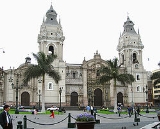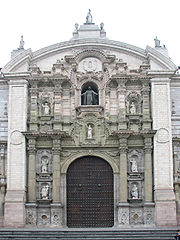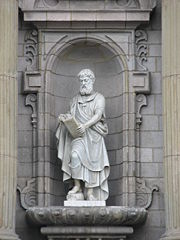
Lima Cathedral
Encyclopedia
The Basilica Cathedral of Lima is a Roman Catholic cathedral located in the Plaza Mayor
of downtown Lima
, Peru
. Construction began in 1535, and the building has undergone many reconstructions and transformation since, however it still retains its colonial structure and facade. It is dedicated to St John, Apostle and Evangelist.

 In keeping with the majority of cathedrals the front facade has three large doorways. The main or central gateway is called the Portada del Perdón or the "door of forgiveness". Above the doorway, instead of Lima
In keeping with the majority of cathedrals the front facade has three large doorways. The main or central gateway is called the Portada del Perdón or the "door of forgiveness". Above the doorway, instead of Lima
's coat-of-arms, there appears the Peruvian seal, and the phrase "Plus Ultra". The two high towers with spire of slate, are neoclassical with stylistic influences of the school "El Escorial" and of northern Europe.
There are also no less than 14 side doors; one of which opens on to Calle de Judíos (Street of the Jews) and another on to the Patio de los Naranjos (Square of the Oranges, connected to the Cathedral). At the rear there are 2 more entrances: Santa Apolonia
and San Cristóbal
. Set on the front facade are sculpture
s of the Apostles and in the middle, the Sacred Heart of Jesus. Adjoining the Cathedral are the Parroquia del Sagrario (one of the oldest ones in Lima) and the Archbishop's Palace.
Inside, along the side aisle
s, are a sequence of large paintings of the Via Crucis, "Way of the Cross. Pope John Paul II visited this cathedral on two occasions, in 1985 and 1988. This is commemorated with signs at the entrance.
In the left aisle, the first chapel
holds the ancient baptistery
. Here can be seen a beautiful image of Nuestra Señora de la Esperanza, who presides over the events during Cuaresm
and Holy Week
. During a recent restoration, ancient pictures were found in this chapel that are now able to be seen by the public.
The next chapel is Capilla de la Sagrada Familia (chapel of the Holy Family
), featuring figures of Jesus
, Mary
and Joseph
.
The Cathedral also contains the tomb of the Spanish conquistador
of Peru, Francisco Pizarro
.
The conqueror Francisco Pizarro
laid the first stone, carrying on his shoulders the first log used in the construction of the Cathedral. The chosen location was between the Main Plaza and the "Street of the Jews," ("Calle de Judíos", in Spanish).
1614-1615: The old Renaissance vaults were rebuilt at a lower height in a Gothic
style.
Plaza Mayor of Lima
The Plaza Mayor or Plaza de Armas of Lima, is the birthplace of the city of Lima, as well as the core of the city. Located in the Historic Centre of Lima, it is surrounded by the Government Palace, Cathedral of Lima, Archbishop's Palace of Lima, the Municipal Palace, and the Palace of the Union.-...
of downtown Lima
Lima
Lima is the capital and the largest city of Peru. It is located in the valleys of the Chillón, Rímac and Lurín rivers, in the central part of the country, on a desert coast overlooking the Pacific Ocean. Together with the seaport of Callao, it forms a contiguous urban area known as the Lima...
, Peru
Peru
Peru , officially the Republic of Peru , is a country in western South America. It is bordered on the north by Ecuador and Colombia, on the east by Brazil, on the southeast by Bolivia, on the south by Chile, and on the west by the Pacific Ocean....
. Construction began in 1535, and the building has undergone many reconstructions and transformation since, however it still retains its colonial structure and facade. It is dedicated to St John, Apostle and Evangelist.
Description


Lima
Lima is the capital and the largest city of Peru. It is located in the valleys of the Chillón, Rímac and Lurín rivers, in the central part of the country, on a desert coast overlooking the Pacific Ocean. Together with the seaport of Callao, it forms a contiguous urban area known as the Lima...
's coat-of-arms, there appears the Peruvian seal, and the phrase "Plus Ultra". The two high towers with spire of slate, are neoclassical with stylistic influences of the school "El Escorial" and of northern Europe.
There are also no less than 14 side doors; one of which opens on to Calle de Judíos (Street of the Jews) and another on to the Patio de los Naranjos (Square of the Oranges, connected to the Cathedral). At the rear there are 2 more entrances: Santa Apolonia
Saint Apollonia
Saint Apollonia was one of a group of virgin martyrs who suffered in Alexandria during a local uprising against the Christians prior to the persecution of Decius. According to legend, her torture included having all of her teeth violently pulled out or shattered...
and San Cristóbal
Saint Christopher
.Saint Christopher is a saint venerated by Roman Catholics and Orthodox Christians, listed as a martyr killed in the reign of the 3rd century Roman Emperor Decius or alternatively under the Roman Emperor Maximinus II Dacian...
. Set on the front facade are sculpture
Sculpture
Sculpture is three-dimensional artwork created by shaping or combining hard materials—typically stone such as marble—or metal, glass, or wood. Softer materials can also be used, such as clay, textiles, plastics, polymers and softer metals...
s of the Apostles and in the middle, the Sacred Heart of Jesus. Adjoining the Cathedral are the Parroquia del Sagrario (one of the oldest ones in Lima) and the Archbishop's Palace.
Inside, along the side aisle
Aisle
An aisle is, in general, a space for walking with rows of seats on both sides or with rows of seats on one side and a wall on the other...
s, are a sequence of large paintings of the Via Crucis, "Way of the Cross. Pope John Paul II visited this cathedral on two occasions, in 1985 and 1988. This is commemorated with signs at the entrance.
In the left aisle, the first chapel
Chapel
A chapel is a building used by Christians as a place of fellowship and worship. It may be part of a larger structure or complex, such as a church, college, hospital, palace, prison or funeral home, located on board a military or commercial ship, or it may be an entirely free-standing building,...
holds the ancient baptistery
Baptistery
In Christian architecture the baptistry or baptistery is the separate centrally-planned structure surrounding the baptismal font. The baptistry may be incorporated within the body of a church or cathedral and be provided with an altar as a chapel...
. Here can be seen a beautiful image of Nuestra Señora de la Esperanza, who presides over the events during Cuaresm
Lent
In the Christian tradition, Lent is the period of the liturgical year from Ash Wednesday to Easter. The traditional purpose of Lent is the preparation of the believer – through prayer, repentance, almsgiving and self-denial – for the annual commemoration during Holy Week of the Death and...
and Holy Week
Holy Week
Holy Week in Christianity is the last week of Lent and the week before Easter...
. During a recent restoration, ancient pictures were found in this chapel that are now able to be seen by the public.
The next chapel is Capilla de la Sagrada Familia (chapel of the Holy Family
Holy Family
The Holy Family consists of the Child Jesus, the Virgin Mary, and Saint Joseph.The Feast of the Holy Family is a liturgical celebration in the Roman Catholic Church in honor of Jesus of Nazareth, his mother, the Blessed Virgin Mary, and his foster father, Saint Joseph, as a family...
), featuring figures of Jesus
Jesus
Jesus of Nazareth , commonly referred to as Jesus Christ or simply as Jesus or Christ, is the central figure of Christianity...
, Mary
Mary (mother of Jesus)
Mary , commonly referred to as "Saint Mary", "Mother Mary", the "Virgin Mary", the "Blessed Virgin Mary", or "Mary, Mother of God", was a Jewish woman of Nazareth in Galilee...
and Joseph
Saint Joseph
Saint Joseph is a figure in the Gospels, the husband of the Virgin Mary and the earthly father of Jesus Christ ....
.
The Cathedral also contains the tomb of the Spanish conquistador
Conquistador
Conquistadors were Spanish soldiers, explorers, and adventurers who brought much of the Americas under the control of Spain in the 15th to 16th centuries, following Europe's discovery of the New World by Christopher Columbus in 1492...
of Peru, Francisco Pizarro
Francisco Pizarro
Francisco Pizarro González, Marquess was a Spanish conquistador, conqueror of the Incan Empire, and founder of Lima, the modern-day capital of the Republic of Peru.-Early life:...
.
Timeline
The following chronological data is based on the work of the priest Antonio San Cristóbal.- January 18, 1535:
The conqueror Francisco Pizarro
Francisco Pizarro
Francisco Pizarro González, Marquess was a Spanish conquistador, conqueror of the Incan Empire, and founder of Lima, the modern-day capital of the Republic of Peru.-Early life:...
laid the first stone, carrying on his shoulders the first log used in the construction of the Cathedral. The chosen location was between the Main Plaza and the "Street of the Jews," ("Calle de Judíos", in Spanish).
- 1538: The construction of the first church was completed. It was mainly built of adobe, primitive, small and rustic.
- March 11, 1540: The church was officially inaugurated by Francisco Pizarro.
- May 14, 1541: A papal bullPapal bullA Papal bull is a particular type of letters patent or charter issued by a Pope of the Catholic Church. It is named after the bulla that was appended to the end in order to authenticate it....
of Pope Paul IIIPope Paul IIIPope Paul III , born Alessandro Farnese, was Pope of the Roman Catholic Church from 1534 to his death in 1549. He came to the papal throne in an era following the sack of Rome in 1527 and rife with uncertainties in the Catholic Church following the Protestant Reformation...
, Illius Fulciti Praesidio, designated the church a Cathedral, by creating the dioceseDioceseA diocese is the district or see under the supervision of a bishop. It is divided into parishes.An archdiocese is more significant than a diocese. An archdiocese is presided over by an archbishop whose see may have or had importance due to size or historical significance...
of the City of the Kings. The Cathedral now became part of the assigned region of Saint John the Evangelist ("San Juan Evangelista" in Spanish) and ceased to depend on CuscoCuscoCusco , often spelled Cuzco , is a city in southeastern Peru, near the Urubamba Valley of the Andes mountain range. It is the capital of the Cusco Region as well as the Cuzco Province. In 2007, the city had a population of 358,935 which was triple the figure of 20 years ago...
. - 1542: The cathedral underwent several improvements and minor extensions, paid for by García de Salcedo.
- September 17, 1543: Bishop Jerónimo de LoayzaJerónimo de LoayzaJerónimo de Loayza González, O.P. was a Spanish Dominican missionary and the first Roman Catholic archbishop of Lima.-Biography:...
signed the "Lima Cathedral Construction Act" and selected its council. - February 12, 1546: The church was upgraded to a MetropolitanMetropolitan bishopIn Christian churches with episcopal polity, the rank of metropolitan bishop, or simply metropolitan, pertains to the diocesan bishop or archbishop of a metropolis; that is, the chief city of a historical Roman province, ecclesiastical province, or regional capital.Before the establishment of...
Church, and "The Kings" became an Archdiocese. This is done by the papal bull Super Universa Orbis of Pope Paul IIIPope Paul IIIPope Paul III , born Alessandro Farnese, was Pope of the Roman Catholic Church from 1534 to his death in 1549. He came to the papal throne in an era following the sack of Rome in 1527 and rife with uncertainties in the Catholic Church following the Protestant Reformation...
. - 1551: Inauguration of the second Cathedral by Archbishop Jerónimo de Loayza.
- 1564: Archbishop Jerónimo de Loayza assigned the task of redesigning the Cathedral to Alonso Beltrán, with instructions to base his design on the Cathedral of Seville in Spain.
- 1572: Work on the third Cathedral began with the demolition of the adobeAdobeAdobe is a natural building material made from sand, clay, water, and some kind of fibrous or organic material , which the builders shape into bricks using frames and dry in the sun. Adobe buildings are similar to cob and mudbrick buildings. Adobe structures are extremely durable, and account for...
walls of the second cathedral, but the project was quickly abandoned because of the high cost. - 1598: The RenaissanceRenaissanceThe Renaissance was a cultural movement that spanned roughly the 14th to the 17th century, beginning in Italy in the Late Middle Ages and later spreading to the rest of Europe. The term is also used more loosely to refer to the historical era, but since the changes of the Renaissance were not...
architect Francisco BecerraFrancisco BecerraFrancisco Becerra was a Spanish architect. Born in Trujillo, he designed and worked on several cathedrals in the New World.Becerra either designed the Puebla Cathedral, or worked on building it to designs by Claudio de Arciniega. He also built several convents in Puebla. He also designed a...
reduced the plans to only 3 aisles, plus 2 chapels. Works on the third Cathedral were recommenced. - February 2, 1604: Archbishop Toribio Alfonso de Mogrovejo inaugurated the first part of the third Cathedral.
- 1609: An EarthquakeEarthquakeAn earthquake is the result of a sudden release of energy in the Earth's crust that creates seismic waves. The seismicity, seismism or seismic activity of an area refers to the frequency, type and size of earthquakes experienced over a period of time...
destroyed the vaultsVault (architecture)A Vault is an architectural term for an arched form used to provide a space with a ceiling or roof. The parts of a vault exert lateral thrust that require a counter resistance. When vaults are built underground, the ground gives all the resistance required...
of the recently built structure. 
1614-1615: The old Renaissance vaults were rebuilt at a lower height in a Gothic
Gothic architecture
Gothic architecture is a style of architecture that flourished during the high and late medieval period. It evolved from Romanesque architecture and was succeeded by Renaissance architecture....
style.
- August 15, 1622: First Mass in the finished third Cathedral.
- October 19, 1625: Archbishop Gonzalo de Ocampo consecrated the third Lima Cathedral.
- 1626: Juan Martínez de Arona and Pedro de Noguera designed the main portal as it is today.
- 1687: Another earthquake1687 Peru earthquakeThe 1687 Peru earthquake occurred at 11:30 UTC on October 20. It had an estimated magnitude of 8.4–8.7 and caused severe damage to Lima, Callao and Ica. It triggered a tsunami and overall about 5,000 people died.-Tectonic setting:...
destroyed the vaults of the Cathedral. - December 7, 1697: Reconstruction of the Cathedral finished and it was officially inaugurated.
- 1732: Two additional portals were added.
- 1746: An Earthquake destroyed many vaults and pillars.
- May 29, 1755: The first part of the rebuilt Cathedral was inaugurated.
- December 8, 1758: The second part of the rebuilt Cathedral was inaugurated.
- December 8, 1778: Archbishop Diego Antonio de Parada inaugurated the renovated interior of the Cathedral.
- 1794-1797: Construction of the current towers of the Cathedral, designed by the architect Ignacio Martorell.
- January 17, 1893: The Cathedral was closed because it was in disrepair and in dire need of restoration.
- January 7, 1896: Internal renovation works were begun.
- January 6, 1898: Inauguration of renovated Cathedral.
- 1940: Earthquake. Restoration by Emilio Harth-Terré.
- 2005: New lights were installed.
Burials
- Augusto Vargas AlzamoraAugusto Vargas AlzamoraAugusto Vargas Alzamora S.J. was a Cardinal Priest and Archbishop of Lima in the Roman Catholic Church.He joined the Society of Jesus in 1940. He studied at the Jesuit Philosophical Faculty in San Miguel, Argentina and Madrid. He continued his studies in Granada, Spain and the University of San...
- Juan GuevaraJuan GuevaraJuan Gualberto Guevara B.A. J.C.D. was created on February 18, 1946 a Cardinal Priest by Pope Pius XII. He was Archbishop of Lima in the Roman Catholic Church. He was the first Cardinal of Peru.-Early life and education:...
- Antonio de MendozaAntonio de MendozaAntonio de Mendoza y Pacheco, Marquis of Mondéjar, Count of Tendilla , was the first viceroy of New Spain, serving from April 17, 1535 to November 25, 1550, and the second viceroy of Peru, from September 23, 1551 to July 21, 1552...
- James Nazrkewich
- Francisco PizarroFrancisco PizarroFrancisco Pizarro González, Marquess was a Spanish conquistador, conqueror of the Incan Empire, and founder of Lima, the modern-day capital of the Republic of Peru.-Early life:...
- Juan Landázuri RickettsJuan Landázuri RickettsJuan Landázuri Ricketts was one of the most prominent Roman Catholic Churchmen during the 1960s and 1970s in Latin America. This was a period in which the Church was compelled to take a strong stand on human rights abuses by numerous military juntas and also concerning problems of extreme poverty...
External links
La Catedral de Lima website by the Roman Catholic Archdiocese of LimaRoman Catholic Archdiocese of Lima
The Roman Catholic Metropolitan Archdiocese of Lima is part of the Roman Catholic Church in Peru which enjoys full communion with the Holy See. The Archdiocese was founded as the Diocese of Lima on 14 May 1541. The diocese was raised to the level of a metropolitan archdiocese by Pope Paul III on ...

